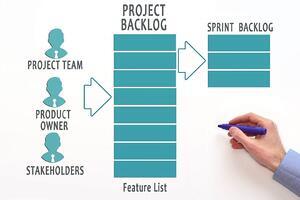Download the PDF brochure of the Professional Scrum Product Owner I (PSPO I) course and print or share with the one that is responsible for the training budget of your company.
Owning It: The Role of the Agile Product Owner

Agile Product Owner in a nutshell
What does the Product Owner (PO) actually do? “It’s quite varied. Some of the PO’s tasks and responsibilities are described in the Scrum Framework. For example, this includes managing the product backlog, maximizing value, and stakeholder management,” says Renate. Furthermore, the Agile Product Owner focuses on all content, asking questions like:
- What are we going to do?
- Why are we doing this?
- What is the underlying vision?
By answering these questions, the Product Owner can define the desires of the client or stakeholder. “This role is often compared to that of a traditional product manager, but while the latter focuses primarily on writing plans and structuring and organizing projects, the Agile Product Owner thinks in terms of the question or issue at hand,” says Renate. “The Development Team then determines how to deal with all the gathered information from a technical perspective. Together with the Scrum Master, the Product Owner tries to create a situation in which the team can perform at its best.”
Theoretically speaking: Product Owner tasks according to the theory
From a purely theoretical viewpoint, the tasks of the Product Owner consist of dialogue with clients and stakeholders. “’Stakeholders’ refers to all those operating in the Product Owner’s organization, such as a marketing team working on a specific app, the Finance Department focusing on internal applications like the ERP system, or HR making improvements to the payroll and staff administrative processes,” says Renate.
It is theoretically preferable that the Product Owner also visits clients – other companies that buy their products – in order to closely monitor demands and developments in the market. The PO also works together with the Development Team in order to answer any questions that arise.
Decision, prioritizing, protecting: Product Owner in practice
In practice, the Agile Product Owner is in the perfect position to make difficult decisions. They make these necessary choices and determine which activities are to be dealt with by the Development Team. “Because the Product Owner is informed about the full context in which decisions are made, they can consequently substantiate all decisions – even saying ‘no’ to stakeholders – if certain requests don’t have the highest priority.” says Renate. “This enables the Product Owner to protect one of the most important pillars in the process: the Development Team.”
Because the Product Owner is informed about the full context in which decisions are made, they can consequently substantiate all decisions.
Responsibilities of the Product Owner
By clearly explaining and maintaining priorities among stakeholders and clients, team members can focus on doing their work well and on providing value. Other responsibilities of the Product Owner include:
- Keeping the backlog up to date, always based on client priority
- Translating the technical landscape, based on client preferences and vice versa, as well as describing this in user stories
- Making sure that the Development Team meets the quality standards of the stakeholder and client
- Ensuring that the Development Team understands the items in the product backlog
- Involving stakeholders and clients in the Sprint Review and in receiving feedback
- Creating a vision of the end product and monitoring developments in the market

True stories: Importance of the Product Backlog
The product backlog is the single source of truth. It is an endless to-do list that includes all stakeholder desires. “Normally, the idea is to cross off everything on such a list, but that is not the objective in Scrum,” says Renate, because “the product is never finished in principle.” She offers a few facts:
- The product backlog always contains relevant information that is available to members of the Scrum Team and stakeholders. They can view the position of their items and what exactly the Development Team is working on.
- The product backlog is a smart document, in which the order of items is determined based on priorities. The higher an item is on the product backlog, the more detailed the development of the corresponding user story must be in order to finish the item in the upcoming sprint.
- The acceptance criteria and requirements need to be worded in a way that is easy for everyone to understand, including those who do not know the background of the topic, as well as the people who are not technically well-versed and/or experienced.
- The items lower on the product backlog are not yet developed since, after all, they may change as a result of changes in the item above them.
Download Brochure

Priorities in the product backlog
The Agile Product Owner must engage in quite a few conversations in order to learn the point of departure and determine the most important item within the context. In fact, they need to be abreast of all aspects, since the Product Owner role is the link between all of the desires in the product backlog. This includes being aware of the value of stakeholders who are less prominent. “Only then is it possible to create a complete overview of the product to be delivered. Product Owners often have a difficult time making the backlog transparent and easy to understand. This is partly because priorities determine collaboration. and the product backlog represents numerous interests,” explains Renate.
Owning the challenges of the Agile Product Owner
The Agile Product Owner is a challenging role in which you are at the center of the action – you really own it. You are the sole contact person for all parties involved, and you must always make sure that value is created continuously within the project. “This means that you must stand your ground in terms of decisions made. In order to prioritize correctly, the mindset, Scrum principles, and values of the Agile Manifesto are absolutely essential,” notes Renate. “During our Scrum Product Owner with PSPO I training course, these aspects are dealt with at length, so that you can make well-founded decisions and substantiate them, all while enjoying the trust of every party involved.”
Author The role of Agile Product Owner: Renate Cremer

Renate Cremer is a certified Scaled Agile Program Consultant (SPC) and therefore authorized to teach and examine the following Scaled Agile courses: SAFe Agilist (SA), SAFe Practitioner (SP), SAFe PM / PO (SPMPO), SAFe Scrum Master ( SM). In addition, she is authorized to teach, facilitate and examine for Agile Scrum Foundation (Exin), Professional Product Owner (PSP01), Professional Scrum Master (PSM1) of Scrum.org and is DISC certified.
